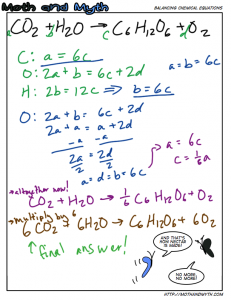If you’re anything like me, when your chemistry teachers taught you how to balance chemical equations, it was mostly a bunch of guesswork. Like, “Try it until it works!” And it was frustrating and you were like, “There’s gotta be a better way!”
Well, there is! Through algebra linear equations!
First! You count out the molecules and stick them in their own linear equations. ‘
For instance, let’s look at the original unbalanced equation:
CO2+H2O -> C6H12O6+O2
Now, put coefficients in front of each of the molecules.
aCO2+bH2O -> cC6H12O6+dO2
According to the equation, there is “a” number of carbon atoms to start with, and there is “c” number of C6 (or “c” number multiplied by your six carbon atoms). So! That becomes:
Carbon atoms: a = 6c
Do that with all of the atoms, O and H, and you’ll get the starting equations which are shown in green.
Carbon atoms: a = 6c
Oxygen atoms: 2a+b= 6c+2d
Hydrogen atoms: 2b=12c
Then! You’ll be able to do substitution solving a system of linear equations. You know, through solving for b, that b = 6c (solving for Hydrogen), and you know that a = 6c as well (solving for Carbon). So, thus a = b, and a = b= 6c.
So… what is d?
Plug in what you know in the equation you have for Oxygen:
Oxygen atoms: 2a+b=6c+2d
Substitute a in everything:
2a+a=a+2d
2a=2d
a=d
So, a=b=6c=d
Now, all we need to do is solve for c [a=6c => c=(1/6)a] and we have all our coefficients!
We can assume that a=1 and write:
CO2+H2O -> (1/6)C6H12O6+O2
Or, we can assume that a=6, so that it looks nice and even:
6CO2+6H2O -> C6H12O6+6O2
And that’s how you balance equations using linear systems of equations.
If you have any questions, feel free to comment and ask!










